The Asian Longhorned Beetle and Connecticut
Protect Connecticut forests - be aware of the Asian longhorned beetle (ALB). This insect, which is devastating to trees, is in both New York and Massachusetts, so it may already be in Connecticut.
Overview
A Quick History (Where ALB has been found in North America)
Why the ALB Is of Such Concern to Connecticut
What Will Happen if ALB Is Found in Connecticut
Biology of the ALB
Trees at Risk from the ALB
Indications that the ALB May Be Present
What to Do if You May Have Found ALB
Other Sources of Information
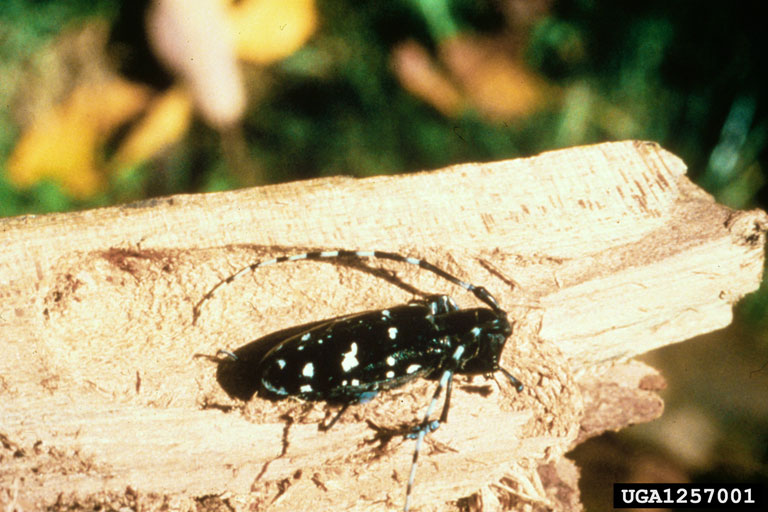
The Asian Longhorned Beetle
Kenneth R. Law, USDA APHIS PPQ, Bugwood.org
The ALB is one of several exotic pests that may affect trees in Connecticut over the next several years. Some, such as the emerald ash borer, have already proven their potential to be devastating. To protect trees, people in the state need to be watchful and also careful. Spotting potentially harmful insects early helps limit the amount of damage that can be caused. Practices such as using only locally grown firewood reduces our vulnerability. All efforts help greatly.
Overview
Among the many threats to the trees in Connecticut, the threat from non-native insects is second only to catastrophic storm damage. Insects on this list include the spongy moth, the Japanese beetle, the hemlock woolly adelgid and the European elm bark beetle. Very shortly, there may be a new pest included – the Asian longhorned beetle (ALB). The best strategy regarding this insect, if it is in Connecticut, is to find it early and then eradicate it, before it can spread any further.
That is not necessarily an easy task. The ALB is a large, shiny, mostly black and very distinctive looking insect. It also tends to spread slowly and to prefer the tops of trees, at least initially. As a result, despite its size, it can be very difficult to spot in the field.
Likewise, the damage it does to trees is, at first, not very noticeable. There is no one thing that the ALB does that announces its presence, and so an infestation can persist and grow at a low level for years. To have a reasonable chance of finding this insect, it will require the vigilance of many people – including professionals and concerned citizens alike.
A Quick History (Where ALB has been found in North America)
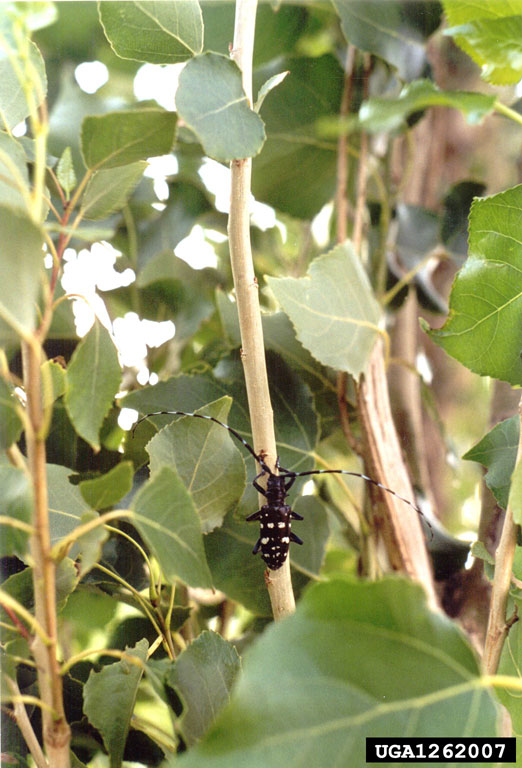
ALB Male on Poplar in China
Michael Bohne, Bugwood.org
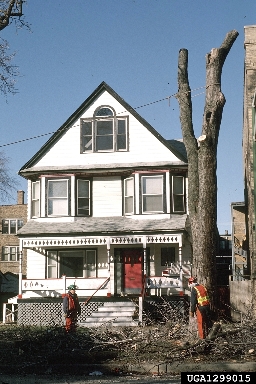
Street Tree Removal in Chicago
USDA ARS Archive, USDA Agricultural Research Service, Bugwood.org
The ALB is native to the forests of China and Korea. Following increased trade between the US and China the beetle began entering the United States in the 1990’s, due to this same poplar wood being used for packaging and dunnage.
The ALB was first found in North America in 1996 in Brooklyn, NY – soon followed by finds in the Bronx, Queens and out on Long Island. Subsequent infestations have also been found in Chicago (1998); Jersey City, NJ (2002); Carteret, NJ (2004); Ontario, Canada (2005) and various NYC locations, including Central Park in Manhattan and on Staten Island (2007). It has also been found in Ohio (2011) and in Central Long Island (2014). There have been some satellite infestations – outbreaks initiated by wood carried from an already occurring infestation – but most of these finds are from initial infestations – beetles that escaped into the landscape directly from cargo carried into North America.
Interestingly, in each of these cases the beetle was first found by a member of the public, not by a professional.
The most severe infestation to date is the one in Worcester, MA. This outbreak was discovered on August 2, 2008, by a woman who was curious about large beetles she kept finding in her backyard. Estimates are that this infestation was at least twelve years old at the time of this discovery. Immediately upon discovery, experts went to work to survey and plan the eradication of this infestation. As of October 2019, the quarantine area from this infestation has spread to 110 square miles and has led to the removal of nearly 30,000 trees – with the work of handling this infestation still ongoing.
In July of 2010, a very small infestation of beetles was discovered in Boston, on the grounds of Faulkner Hospital, just across the street from the Arnold Arboretum. Fortunately, when the groundskeeper for the hospital alertly spotted the beetles, they had only spread to six trees, all red maples, and had not yet moved onto the many additional potential host trees on the grounds. This individual's vigilance probably saved one of the country's premier tree collections. While the results of genetic testing have been inconclusive there, it is largely suspected that this infestation began with beetles moved from Worcester, on firewood, scrap wood or by some other incidental means. It is estimated that the Boston infestation was about 3-5 years old when discovered.
As a result of these discoveries, since 1998, extensive phytosanitary standards have been put into place regulating the movement of wood of any kind from outside of North America. These standards include the heat treating of pallets and other packaging material and increased inspections at the ports before shipping and unloading. It appears that these standards are working. The likelihood is that all of the major infestations found so far in North America were initiated before the adaptation of these strict standards. However, that does not mean that a new, major infestation could not develop from the spread of the ALB from an existing infestation.
It is very challenging that ALB infestations can go undetected for years. This allows the beetle population to grow to large numbers before being discovered. In Connecticut there is concern that the state, with its many ports and freight transportation hubs, may have already received a shipment that included beetle-infested wood, that has led to a yet undiscovered infestation somewhere within its borders. There is also concern that the beetle could easily be carried into the state accidentally from one of the nearby, known infestations, such as in firewood or simply as a hitchhiker on a vehicle.
Why the ALB Is of Such Concern to Connecticut
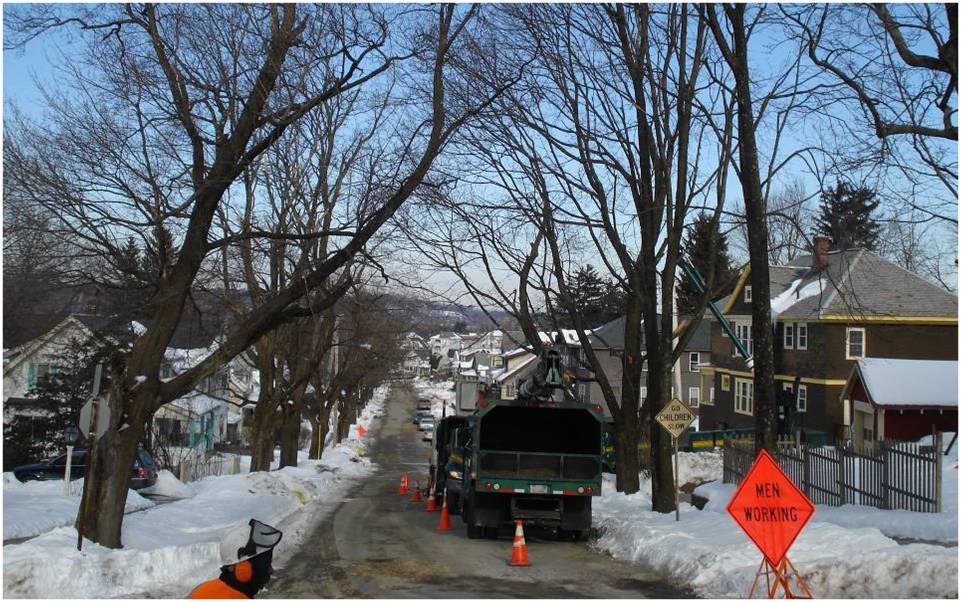
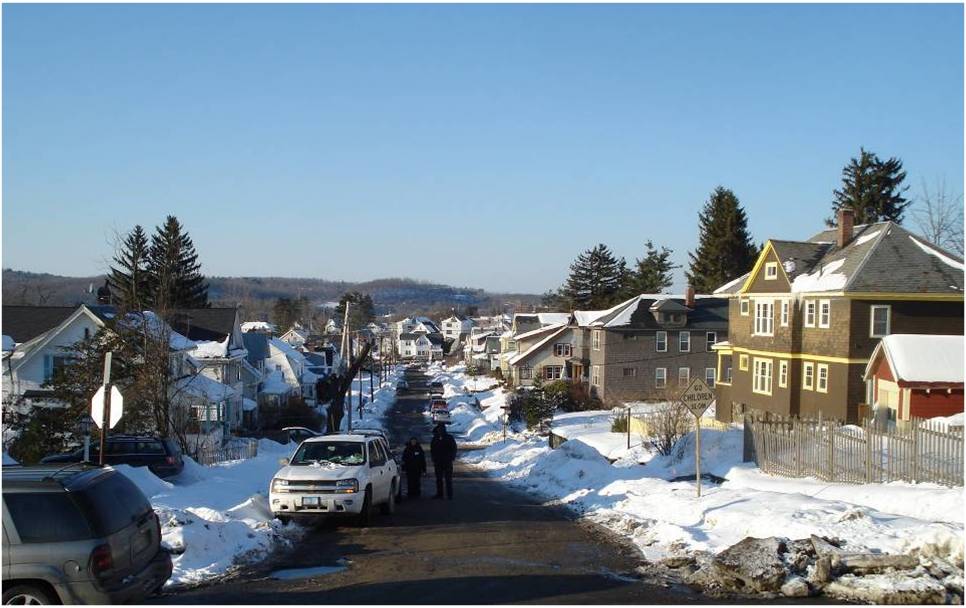
Worcester Street before (left) and after (right) tree removals from ALB
Kenneth R. Law, USDA APHIS PPQ
Arguably, nowhere else in the United States do so many people in one state live in such close proximity to so many trees. The lives of the people of Connecticut are closely interwoven with the trees that grow in our forests, in our yards and neighborhoods, along our streets and our highways, and in our parks and playgrounds. It is estimated that Connecticut is about 60% forested. That percentage does not include those trees that are outside our forests but are in our towns and cities and still very much a part of our daily lives.
The ALB is an insect with a large host range. Approximately 47% of the trees in our forests are considered susceptible to the ALB, with some 32% considered to be highly susceptible (see Tree Lists). If we focus in on the trees in Hartford’s urban forest, the numbers are similar. Based on the number of trees, some 48% of the urban forest is susceptible; based on leaf area, some 59% of the canopy volume of Hartford is vulnerable. A listing of street trees in Milford shows that more than half of the trees along the 220 miles of roads in that city could be lost.
The economic importance of trees should not be overlooked in this discussion. Fall foliage season is Connecticut’s second busiest time for tourism, with maples, one of ALB’s favorite targets, being a key contributor to nature’s annual display of color. Likewise, the maple syrup, forest products and nursery industries are all important in Connecticut. Each of these faces potential harm from the beetle. Further, these threats are only the tip of the iceberg. Additional financial threats include loss of property values, increased energy heating and cooling costs, loss of recreational values in our parks and forests, enormous tree removal and replanting costs, and so on. Depending upon the size of the infestation, the presence of the beetle could be an economic disaster for the state.
What Will Happen if ALB Is Found in Connecticut
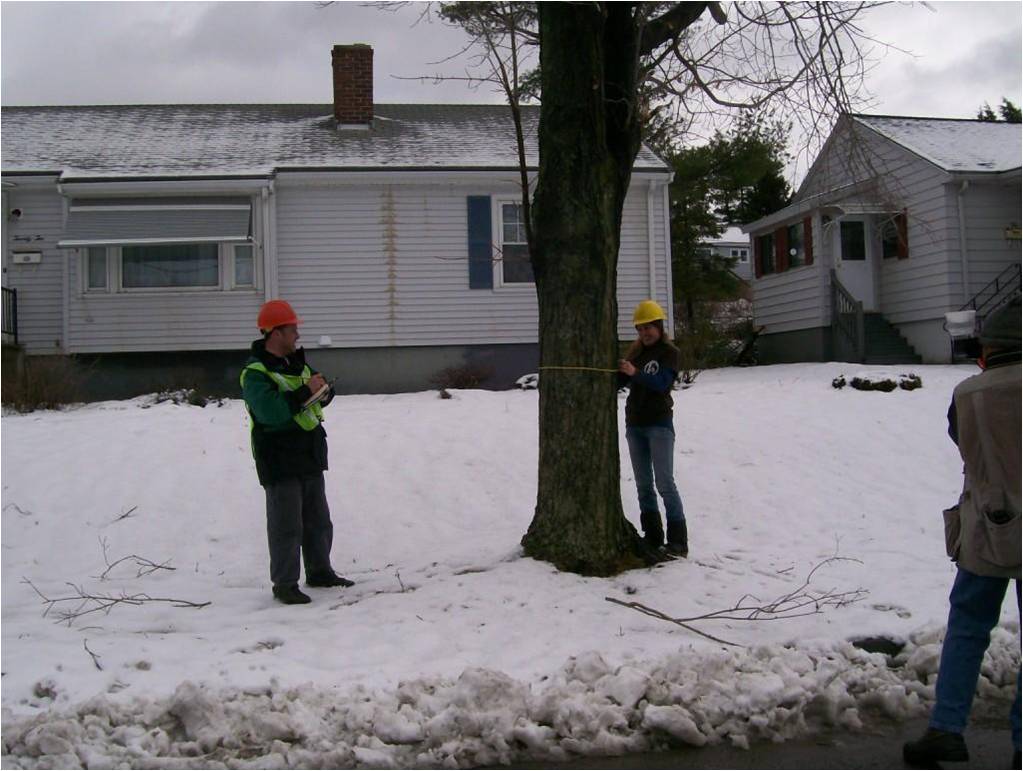
Surveying Trees in Worcester
Patty Douglas, USDA APHIS PPQ
The ALB is an insect of federal regulatory concern. Upon the beetle being found, this status obligates the federal government to take direct action, in partnership with various state agencies and local entities. The goals of this action are twofold - to contain the ALB so that it does not spread from the site of infestation and to eradicate it within the area infested.
From the federal side, the main department responsible for taking action is the United States Department of Agriculture (USDA). The two units of USDA most directly involved in ALB efforts are the Animal and Plant Health Inspection Service (APHIS) and the Forest Service (USFS). In these infestations, APHIS takes the lead, with USFS and state and local entities assisting.
Within Connecticut, the main state agency responsible for responding to the ALB is the Connecticut Agricultural Experiment Station (CAES). The Connecticut DEEP would also have a critical role in the response, particularly through the Division of Forestry but also through the EnCon Police and the Pesticide Management Program.
In the initial response, the first item of business will be to locate as many of the infested trees as possible and then to establish a quarantine area. The purpose of the quarantine area is to see to it that no large pieces of wood from ALB susceptible trees leave from the infested area. That includes lumber, nursery stock, trunk wood, branches, stumps, roots and all species of firewood. All who work within the quarantine area removing or treating trees will need specialized training so that this work does not then become a means for the further spread of the insect.
Biology of the ALB
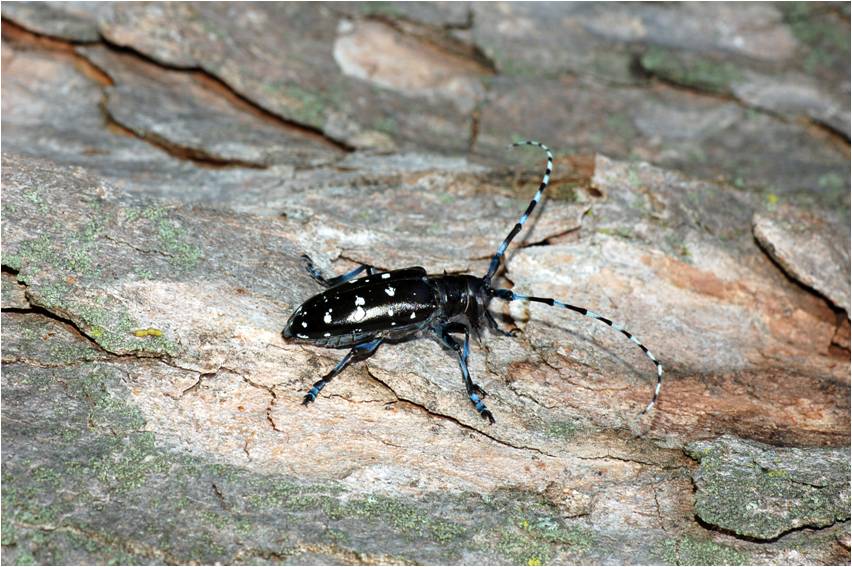
Adult Asian Longhorned Beetle
Peter Trenchard, CAES
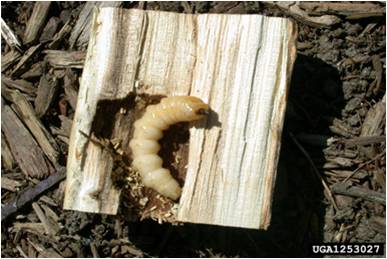
Larval Asian Longhorned Beetle
Thomas B. Denholm, New Jersey Department of Agriculture, Bugwood.org
Description of the Insect
The adult ALB is a jet-black, glossy beetle whose wing covers are marked with distinct white patches. It is a large insect. The body of the adult female is about 1 inch to 1-½ inches in length and 3/8 to ½ inch in width. The adult male is slightly smaller. The ALB is a longhorned beetle (a cerambycid), which means that its antennae are very long relative to the body. The female’s antennae are about 1.2 to 1.8 times its body length, while the male’s antennae are about 1.6 to 2.1 times its body length.
The details of the ALB’s appearance are very helpful in distinguishing it from several look-alikes. The size and glossy appearance of the ALB are each key characteristics. Also, the alternating blue-white and blue-black pattern on its antennae and the bluish tinge to the legs are also important indicators. The beetle most frequently mistaken for the ALB in Connecticut is the whitespotted sawyer, a native longhorned beetle that attacks pines. The whitespotted sawyer can be distinguished from the ALB in part because it is not nearly as glossy at the ALB, and in part due to differences in its spotting pattern.
The Connecticut Agricultural Experiment Station has produced a poster ready for download showing the most common ALB look-alikes.
The ALB is a poor flyer that continually re-infests the same tree. Populations on an infested tree tend to get quite large before the beetle moves on to adjacent, susceptible trees.

ALB Life Cycle
Diagram by Michael Bohne, Bugwood.org; Published by the University of Vermont (2001)
Life Cycle
The ALB undergoes a complete metamorphosis. Its life cycle consists of four stages: egg, larva, pupa and adult. The egg is laid by the female ALB at the base of a crater she chews into the bark of the tree, until the very bottom of the crater just contacts the cambium. The crater, or oviposition site, is irregularly oval, circular, oblong or even linear in shape, and about the size of a dime. In a tree that is not heavily infested, oviposition sites are more common near to the top of the tree and on branches that are not smaller than an inch in diameter. In a tree that is heavily infested, oviposition sites may be found anywhere on the tree, even on exposed roots and on the trunk, where the bark is thickest.
After completing the excavation of the crater, the female beetle then lays a single egg. A single female will lay eggs at multiple sites, with one female capable of laying up to 90 eggs. When the egg hatches, the newly emerged larva feeds upon the cambial and sapwood tissues in the vicinity of the oviposition site. As it increases in size, the growing larva turns and burrows its way into the heartwood of the tree. The ALB larva typically has 5 instars (growth stages) and becomes quite large – on the order of 2 inches in length – before becoming a pupa.
The life cycle of the ALB crosses from one growing season into the next, with the insect overwintering as a larva in the heartwood of the tree. Pupation takes about 20 days, and the adult beetles begin emerging from late June and early July. Emergence continues until the first hard frost of the fall. In more northerly areas, eggs laid in the late season may overwinter as eggs, and the life span of those insects may extend over three growing seasons before reaching maturity. Before pupating, the larva often turns outward and begins burrowing towards the outside of the tree, establishing a pupal chamber in the sapwood under the bark.
The adult beetles are active reproductively from when they emerge until the first hard frost. Adults feed minimally and the distinctive feeding habits of the adult female can serve as an indicator of the presence of the beetle. Adult females feed on the midrib of leaves, on leaf petioles and on the thin bark of twigs. Following mating, male beetles will mate-guard a female to protect his genetic contribution as she chews an oviposition pit and lays an egg.
Not much is known about possible causes of mortality for the beetles, other than the cold weather of late fall. Specific predators, parasites or diseases that would reduce beetle numbers have not been recorded.
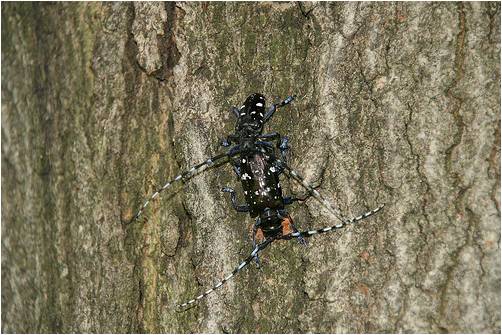
Mate Guarding (male guards female as she chews oviposition pit)
Michael Bohne, Bugwood.org
Trees at Risk from the ALB
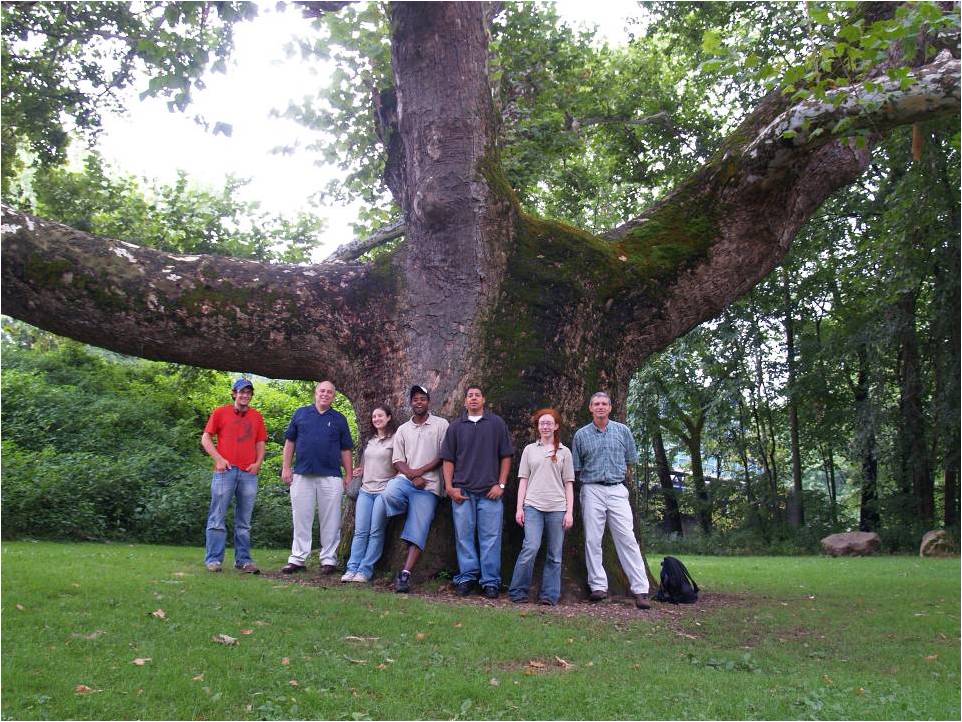
Pinchot Sycamore with Hartford Summer Crew
Chris Donnelly, CT DEEP
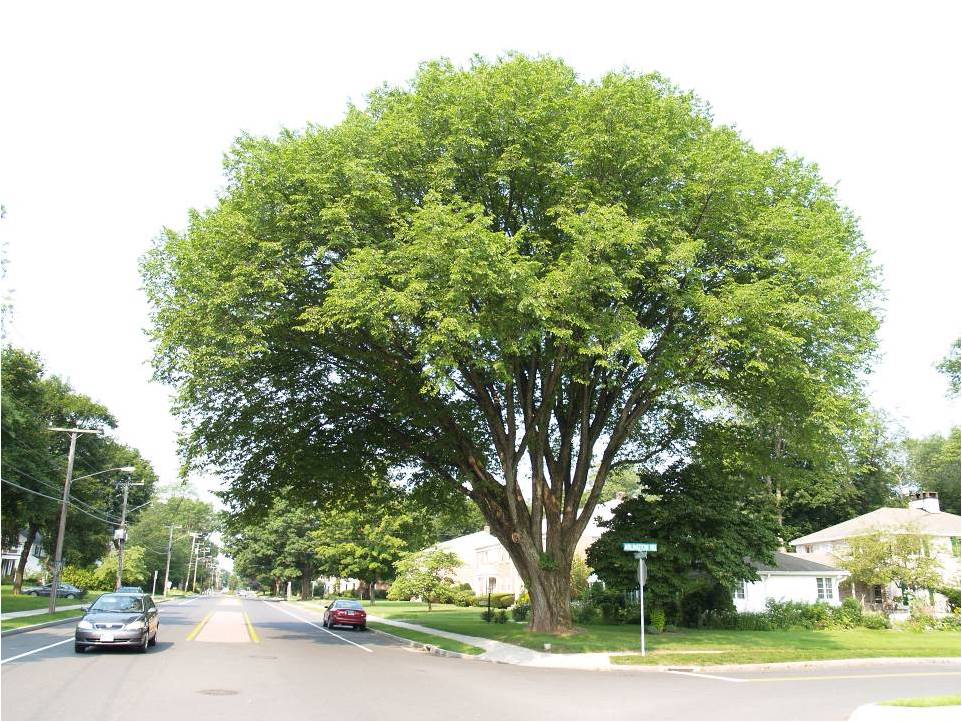
Elm in West Hartford
Chris Donnelly, CT DEEP
The ALB is notable for its wide range of potential host trees – it is one of the reasons why it is of such great concern and is so difficult to combat. While it was poplar trees in China that had a major role in causing the ALB to arrive in North America, it has been its attacks on maple trees on this continent that have been most noted. Altogether, there are at least 11 genera of trees that ALB is known to attack in North America, with more likely to be discovered.
The ALB only attacks hardwoods – it has no known gymnosperm hosts. Thus, pines, spruces, firs, hemlocks and other conifers are safe from this insect.
The following are among the genera most at risk from ALB, with some comments on each:
Maples: All maples appear to be at risk from ALB. As the maple species are among some of the most important trees in Connecticut, this is of great concern. Maples in Connecticut include sugar maple, red maple, silver maple and box elder. Norway maple is one of the most common street trees in the state, but is also considered to be a potentially invasive non-native, and so is losing favor among those who plant trees. The Crimson King variety of the Norway maple continues to be a very popular tree for homeowners. Also there are many smaller maples that are highly prized as ornamentals, including the Japanese maple, hedge maple, paperbark maple and the striped maple.
Elms: Prior to the advent of Dutch elm disease, the American elm had been considered the proto-typical American street tree, renowned for its size, hardiness and graceful shape and beauty. Extensive efforts to bring back the beauty of the elms have led to the introduction of many new species and varieties of elms, including hybrids. The genus remains a major component of both our forests and our landscapes. The many recently introduced, disease resistant American elms are leading this species to a renewed popularity.
Willows: While not as commonly planted as either elms or maples, willows are still an important part of our landscape, particularly weeping willows. These trees are often seen as part of the vista along lakes and streams and in wet areas. Pussy willows shrubs, a harbinger of spring for many people, were noted as being especially vulnerable to attack during the NYC ALB outbreak.
Birch: The lighter colored birches – paper, grey and ornamental white birches – are known to be hosts of the ALB. The darker birches, such as the black and yellow birches, are not considered to be as susceptible to the beetle. Black and yellow birches, the two species with the characteristic ‘birch beer’ scent, are major components of our woodlands, while grey birch is common in old field settings. The white birches generally are very popular landscape trees.
Horsechestnuts (buckeyes): Horsechestnuts and buckeyes are best known in Connecticut as landscape trees. Due to their showy blossoms and their interesting, palmate compound leaves, they are often a signature specimen where planted.
Sycamores and London Planes: The American sycamore is the largest tree species east of the Mississippi. Indeed, the largest tree is Connecticut is the Pinchot Sycamore, in the Weatogue section of Simsbury. This perhaps 400 year old giant is about 9 feet in diameter, 95 feet tall and has a canopy spread of around 140 feet. Other nearly as majestic native sycamores dot the Connecticut countryside. Meanwhile, the London plane tree, a cross between the American and the Oriental sycamore, is one of the more common street trees, known for its resistance to pollution, other insects and diseases.
Poplars: The genus Populus is fairly common throughout Connecticut. This includes trembling aspen, big-toothed aspen and the cottonwood. The Tulip Poplar is not actually in the Poplar family, and is not susceptible to ALB.
Among the other genera known to be susceptible to the ALB are the hackberries, the mountain ashes, true ashes and the silk tree.
Trees largely considered to not be at risk from the ALB include the oaks, apples, pears, hickories, beeches, honey locusts, dogwoods, walnuts, magnolias, tree-of-heaven, lilacs, viburnums and all of the conifers.
Indications that the ALB May Be Present
The best indication of the presence of an ALB infestation is the insect itself. While the insect is large and striking in appearance, it also can be very hard to spot. Other good indicators that point to the presence of the ALB are:
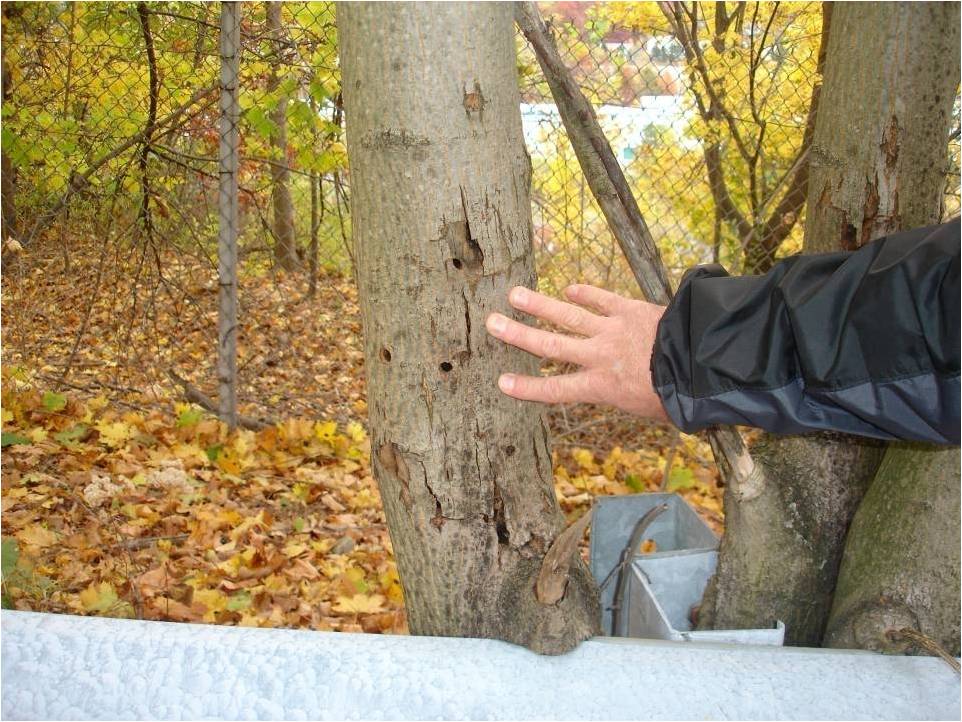
ALB Exit Holes
Peter Trenchard, CAES
Exit holes: ALB exit holes are circular and large – on the order of ¼ to ½ inch in diameter. Exit holes may be anywhere on the tree. It is good to inspect branches that have been pruned or fallen from the tops of trees, as that is where infestations usually begin. There are also exit hole “look-alikes”, including the exit holes of the leopard moth and the feeding marks of sapsuckers.
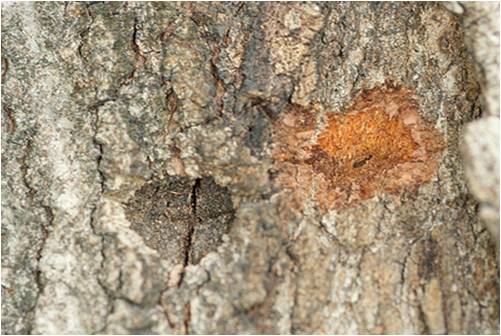
Old and New ALB Oviposition Sites
Peter Trenchard, CAES
Oviposition sites (pits): These craters chewed into the bark can be any shape from nearly circular to a long trench. Typically, if roughly circular, they will be ½ inch or so in diameter, or about the size of a dime. As these pits are chewed out by the female, the marks of her mandibles can be seen around the edges of the pit. When freshly made, the pit often stands out due to the contrast between the outer and inner bark. As the wound oxidizes and then as the tree responds, there is a marked loss in this color contrast.
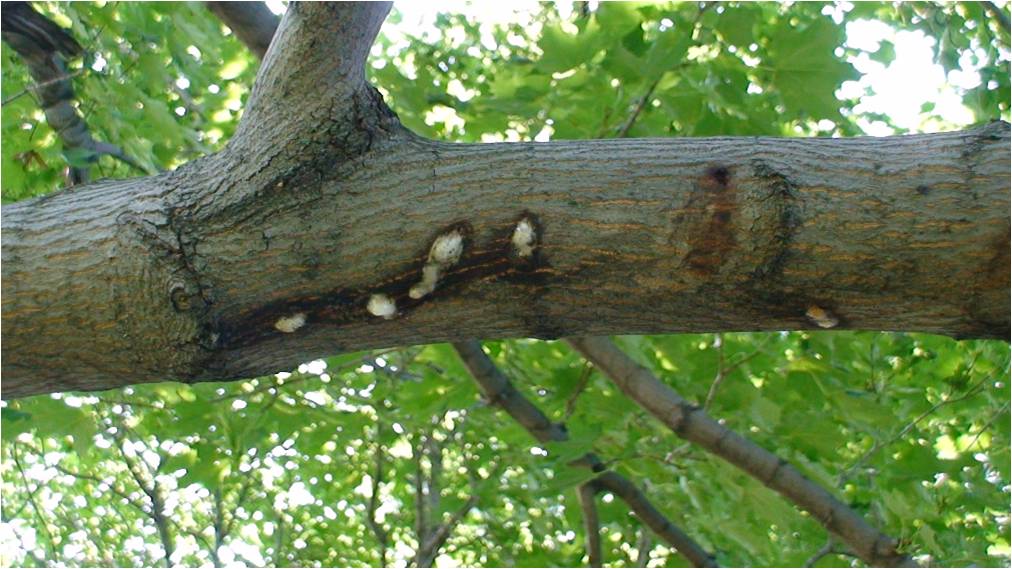
Sap Frothing from Oviposition Sites
Peter Trenchard, CAES
Frothing sap: After the adult female has chewed an oviposition pit, the tree may begin bleeding sap. In turn, this sap often begins to ferment, becoming frothy or foamy and attracting other insects that feed on the sap.
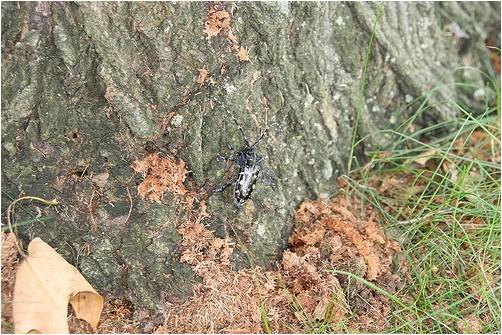
Frass at Base of Maple (with ALB)
Peter Trenchard, CAES
Frass: As the larva feeds, the solid fecal matter it generates is mixed with the wood shavings that also result from its feeding. This mixture is known as frass. As the larva feeds, it pushes frass back out of its tunnel, where it may be seen protruding from cracks in the bark of the tree or on the ground or caught in the crotches of infested trees. The frass from the ALB is relatively large and coarse as compared to that from other insects, such as carpenter ants or carpenter bees.
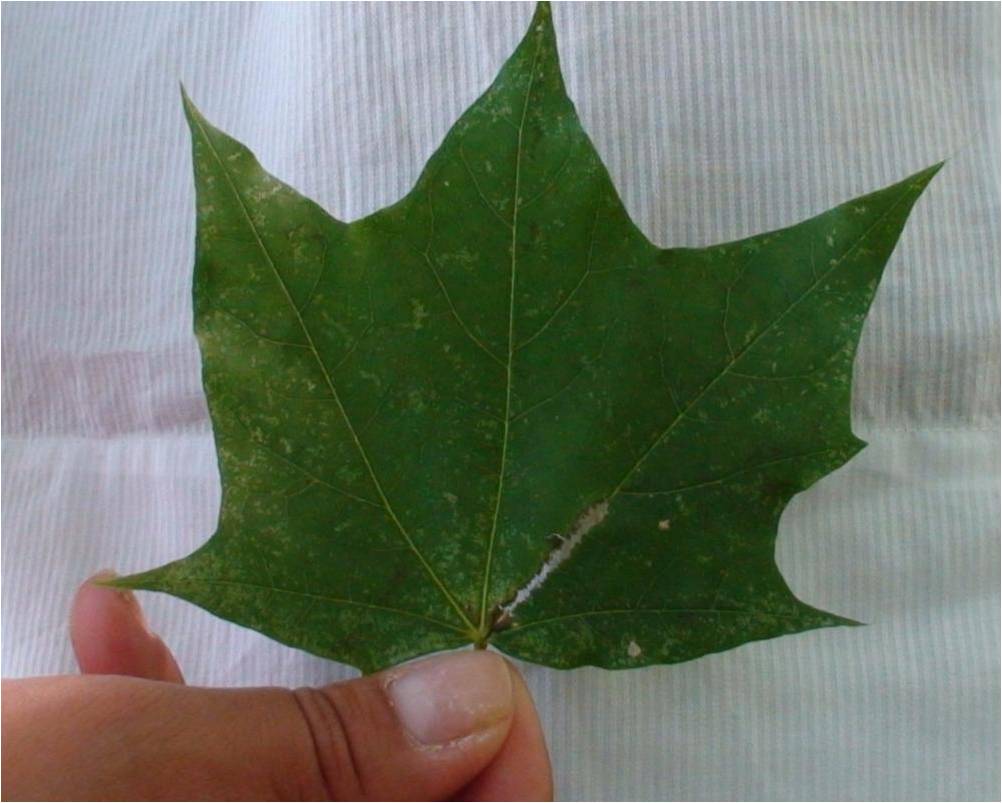
Midrib Feeding from Adult ALB
Peter Trenchard, CAES
Characteristic adult feedings: The adult female feeds on the main and secondary veins of leaves of susceptible trees, and occasionally also strips off the surface layer from the petiole and from the twigs of these same trees. As this feeding pattern is not commonly observed with other insects, it can be considered a good indicator of the presence of the ALB.
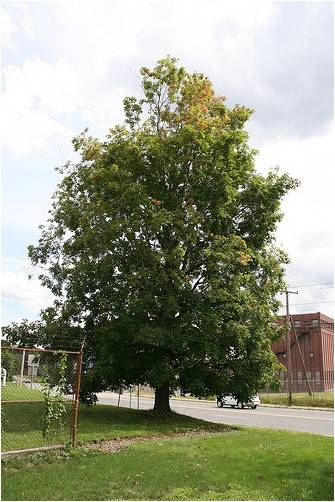
Worcester Tree, heavily infested; likely one of the first trees infested.
Peter Trenchard, CAES
Tree condition: Indicators such as those listed above may give readily visible evidence, but are usually difficult to spot. Often an ALB infested tree does not look very different from others around it that are not infested. However, as the infestation progresses and the beetles continue to use the tree, the damage to the bark can cause dieback throughout the crown of the tree. The continual tunneling within the wood of the tree also structurally weakens branches and trunks, eventually increasing the likelihood that the tree will begin to fall apart, particularly during storms.
What to Do if You May Have Found ALB
First, and most important – if you think you may have found the ALB, do not attempt to move the insect, or to move any wood or other potentially infested material from the site. Instead, take lots of photos and make careful note of the location, and then get in touch with the Connecticut Agricultural Experiment Station. Send an email or digital photos of suspected ALB or ALB indicators to CAES.StateEntomologist@ct.gov. The Station is responsive to emails, and they will follow up on all potential spottings.
If circumstances determine that you need to capture the beetle, then be sure to use a glass jar with a metal lid. These are insects that chew their way through trees; plastic will not hold them. Then, the best course is to either leave the insect in place at the site or place into a freezer for at least two days, to kill it.
Even then, do not move the insect and, especially, do not move any associated wood. If this is an ALB, where is one adult there are likely to be others. Moving anything from the site increases the chance of its spread.
Because of the number of the trees that potentially may be removed following the discovery of an ALB infestation, there might be some reluctance to report an ALB find. While that reluctance is understandable, the consequences of not reporting an infestation is worse. The longer an infestation persists, the larger the population of beetles will grow and the greater the extent of the impact will be. The feeding by the beetles can sufficiently girdle the tree so as to kill it outright or make it vulnerable to other pests, or the burrowing in the wood can so weaken the tree structurally that it falls victim to a storm.
The public’s cooperation in this effort to find the beetle in order to protect trees and to limit the beetle's spread is greatly appreciated.
Other Sources of Information
Asian Longhorned Beetle and Its Host Trees
(publication by USFS and the University of Vermont)
Forest Service Asian Longhorned Beetle Pest Alert
CT Agricultural Experiment Station Special Features Page
Massachusetts ALB Cooperative Eradication Program
University of Vermont ALB Page
Content last updated in March 2022.

